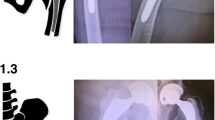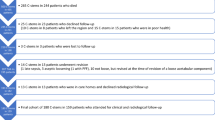Abstract
Background
Periprosthetic fractures can occur both intraoperatively and postoperatively with implantation of cementless tapered stems.
Questions/purposes
In a large cohort of patients receiving cementless, proximally hydroxyapatite-coated femoral implants, we answered the following questions: What was the incidence of intraoperative and postoperative fractures associated with the implant? What were the fracture patterns as classified by the Vancouver classification system? Did the Vancouver classification represent the fracture patterns found? How were the fractures treated and what were the treatment outcomes; that is, how many fractures healed and did the stems osseointegrate?
Methods
We evaluated 1039 hips (932 patients) from three prospective studies. The hips were divided into three groups: no fractures, intraoperative fractures, and postoperative fractures. Demographic differences among the groups were noted. Postoperative fractures were classified using the Vancouver classification system. We judged stem stability using Engh’s criteria and fracture union was determined by the treating surgeon and confirmed by the authors.
Results
We identified 58 periprosthetic fractures in the 1039 hips (5.6%): 38 intraoperative (3.7%) and 20 postoperative (1.9%). Eleven of the postoperative fractures were classifiable by the original Vancouver classification system and nine were of the newly described “clamshell” variety, not classifiable by this system. No intraoperative fractures extended below the lesser trochanter. Twenty-five of these fractures were treated with a single cable or cerclage wire. The remaining received no specific treatment. Of the 20 postoperative fractures, five were treated nonoperatively. All stems osseointegrated.
Conclusions
Both intraoperative and postoperative fractures can be managed with success when the stem is stabilized or found to be osseointegrated. An adjustment to the Vancouver classification is suggested to include the clamshell fracture, which has not been previously described.
Level of Evidence
Level IV, therapeutic study. See Instructions for Authors for a complete description of levels of evidence.


Similar content being viewed by others
References
Berend KR, Lombardi AV Jr, Mallory TH, Chonko DJ, Dodds KL, Adams JB. Cerclage wires or cables for the management of intraoperative fracture associated with a cementless, tapered femoral prosthesis: results at 2 to 16 years. J Arthroplasty. 2004;19(suppl 2):17–21.
Cook RE, Jenkins PJ, Walmsley PJ, Patton JT, Tobinson CM. Risk factors for periprosthetic fractures of the hip a survivorship analysis. Clin Orthop Relat Res. 2008;466:1652–1656.
Corten K, Vanrykel F, Bellemans J, Reynders Frederix P, Simon JP, Broos PL. An algorithm for the surgical treatment of periprosthetic fractures of the femur around a well-fixed femoral component. J Bone Joint Surg Br. 2009;91:1424–1430.
D’Angelo F, Murena L, Vulcano E, Zatti G, Cherubino P. Seven to twelve year results with Versys ET cementless stem: a retrospective study of 225 cases. Hip Int. 2010;20:81–86.
Duncan CP, Masri BA. Fractures of the femur after hip replacement. Instr Course Lect. 1995;44:293–304.
Engh CA, Massin P, Suthers KE. Roentgenographic assessment of the biologic fixation of porous-surfaced femoral components. Clin Orthop Relat Res. 1990;257:107–128.
Fitzgerald RH Jr, Brindley GW, Kavanagh BF. The uncemented total hip arthroplasty. Clin Orthop Relat Res. 1988;235:61–66.
Lindahl H, Malchau H, Herberts P, Garellick G. Periprosthetic femoral fractures classification and demographics of 1049 periprosthetic femoral fractures from the Swedish National Hip Arthroplasty Register. J Arthroplasty. 2005;20:857–865.
Mallory TH, Kraus TJ, Vaughn BK. Intraoperative femoral fractures associated with cementless total hip arthroplasty. Orthopedics. 1989;12:231–239.
McNally SA, Shepperd JA, Mann CV, Walczak JP. The results at nine to twelve years of the use of a hydroxyapatite-coated femoral stem. J Bone Joint Surg Br. 2000;82:378–382.
Radl R, Aigner C, Hungerford M, Pascher A, Windhager R. Proximal femoral bone loss and increased rate of fracture with a proximally hydroxyapatite-coated femoral component. J Bone Joint Surg Br. 2000;82:1151–1155.
Schroder D, Bornstein L, Bostrom MP, Nestor BJ, Padgett DE, Westrich GH. Ceramic-on-ceramic total hip arthroplasty: incidence of instability and noise. Clin Orthop Relat Res. 2011;469:437–442.
Streit MR, Merle C, Clarius M, Aldinger PR. Late peri-prosthetic femoral fracture as a major mode of failure in uncemented primary hip replacement. J Bone Joint Surg Br. 2011;93:178–183.
Van Houwelingen AP, Duncan CP. The pseudo A (LT) periprosthetic fracture: it’s really a B2. Orthopedics. 2011;34:e479–e481.
Vidalain JP. Twenty-year results of the cementless Corail stem. Int Orthop. 2011;35:189–194.
Acknowledgments
The authors thank Molly M. Moore for assistance with manuscript preparation and Christopher M. Brown BFA, MS for providing illustrations.
Author information
Authors and Affiliations
Corresponding author
Additional information
Two of the authors certify that they (WNC, JAD) have received or may receive payments or benefits, during the study period, an amount of USD 10,000 to USD 100,000 from Stryker Orthopaedics (Mahwah, NJ, USA). One author (MN) is an employee of Stryker Orthopaedics.
All ICMJE Conflict of Interest Forms for authors and Clinical Orthopaedics and Related Research editors and board members are on file with the publication and can be viewed on request.
Clinical Orthopaedics and Related Research neither advocates nor endorses the use of any treatment, drug, or device. Readers are encouraged to always seek additional information, including FDA approval status, of any drug or device before clinical use.
Each author certifies that his or her institution approved the human protocol for this investigation, that all investigations were conducted in conformity with ethical principles of research, and that informed consent for participation in the study was obtained.
This work was performed at Indiana University Medical Center (Indianapolis, IN, USA), Sewickley Valley Hospital (Sewickley, PA, USA), and Stryker Orthopaedics (Mahwah, NJ, USA).
About this article
Cite this article
Capello, W.N., D’Antonio, J.A. & Naughton, M. Periprosthetic Fractures Around a Cementless Hydroxyapatite-coated Implant: A New Fracture Pattern Is Described. Clin Orthop Relat Res 472, 604–610 (2014). https://doi.org/10.1007/s11999-013-3137-x
Published:
Issue Date:
DOI: https://doi.org/10.1007/s11999-013-3137-x




